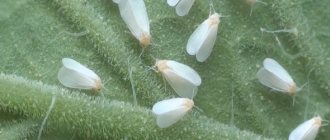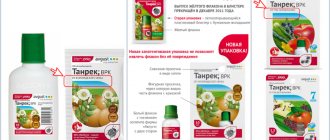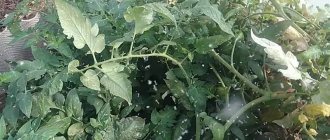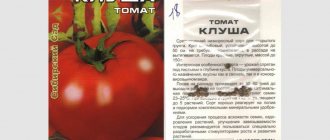Whitefly is a dangerous pest that multiplies quickly under comfortable conditions. Insects are mainly found on plants growing in open ground, because nothing prevents their penetration. But if a whitefly gets on plants in a greenhouse, then the most comfortable conditions will be created for it to reproduce and cause damage to the entire crop. Insects settle on various plants, including tomatoes, cucumbers, zucchini, strawberries, and also on weeds. If nothing is done to eliminate insects, then all greenhouse plants will be eaten simply “before our eyes.” The owner of buildings with tomatoes must figure out how to get rid of whiteflies on tomatoes in a greenhouse.
Signs of the presence of whiteflies on tomatoes
Getting on the leaves of tomatoes, the whitefly can not only spoil them, but also lead to the complete death of the fruit. Insects hide under the lower leaves of vegetables, where they lay eggs. They feed on the juice and water contained in tomato leaves.
When the temperature is favorable, the whitefly will increase in number exponentially. After which it will be much more difficult to remove it.
Whitefly on tomatoes
Important! The whitefly not only draws out all the juices from the plant, but also contributes to the spread of fungi, as a result of which the tomatoes begin to turn black.
Among the signs of plant damage by moths, it is worth highlighting:
- leaves begin to curl and turn yellow;
- white veins form inside the fruit;
- if you touch a bush with tomatoes, many white moths fly up;
- Fruit ripening occurs unevenly.
The fight against whiteflies in a greenhouse on tomatoes will be much easier if you start getting rid of them before they lay eggs. But if the moths have already managed to do this, then the fight against them will take place using various means, depending on the stage of development of the larvae.
How to prevent it from appearing
Actions related to the fight against whitefly should begin in the fall, immediately after harvest. To do this, you need to completely remove plant debris from the greenhouse. This way you will reduce the likelihood of the pest getting into the ground, where it can easily overwinter and wait until spring.
In the spring, at the seedling propagation stage, do not place seedlings next to home crops. The whitefly loves geraniums and pelargonium, from where it moves to young shoots, and with them ends up in the greenhouse. Therefore, try to ensure that indoor flowers and seedlings of tomatoes, cucumbers, and peppers are located on different windowsills.
Description of the pest
Whiteflies always hide at the bottom of leaves on vegetables. During the day they practically do not fly unless disturbed by moving their leaves. At night, the whitefly can fly long distances in search of new plants, and immediately hides under their leaves.
Vegetable pest - whitefly
In appearance, the moth looks like a very small butterfly. Its length is about 1.5 mm, has a white and yellow color and two pairs of wings. Whitefly larvae are light green in color and only 0.3 mm long.
One female moth can lay up to 20 eggs, and up to 130 eggs per month of activity. The hatched larvae immediately attach themselves to the leaves, absorbing their juice. The larva needs 25 days to fully develop.
Attention! In open ground, the whitefly lives only for one season, but in greenhouse conditions it can live throughout the year, during which time it can breed several generations of moths.
At the site of suction, the larvae make a small puncture, from which the leaves gradually begin to turn yellow and stop growing. As a result, the plant dries out completely and does not produce the required amount of harvest. In addition, the insect is a carrier of many infections and viruses.
Aphids or whiteflies?
First of all, learn to identify the first signs of a pest in the greenhouse:
- Stickiness is felt in different places of the plants.
- Leaves are deformed, curled and wilted.
- On the inside of the leaves you see larvae with a waxy coating.
- Some leaf blades of vegetable crops are covered with yellow spots, but the boundaries are unclear.
And finally, just touch the infected bush - a whole flock of small white flies immediately rose and flew to another bush? These are definitely whiteflies. And, if you are not squeamish, take a closer look at one of them - is it similar to the photos below? Let's put it this way: this is a serious threat to your future greenhouse crop. And the strength of these parasites is that there are many of them - hundreds and thousands of small pests that literally draw out all the juices from the leaves and stems. If you do nothing, you will lose all your work in a couple of days.
Please note that if a black coating is also noticeable on the sticky secretions of the parasite, then the plants are already infected with an additional sooty fungus. Such bushes can only be pulled out and immediately burned.
Unfortunately.
Methods of pest control
If whitefly appears on tomatoes, control methods in the greenhouse can be chemical, mechanical and folk. If the first two give quick results, then the use of traditional methods will require frequent repetition of actions to consolidate the result.
We must not forget that in pest control, simultaneous disposal of both larvae and adults occurs.
Mechanical method
If there are very few larvae on the leaves, then you can cut them off and destroy them, or try to wash them off with a soap solution. For adult moths that can fly from plant to plant, hang Velcro, the same as for flies. But if their number is very large, then it is necessary to use special traps.
In the USA, one interesting way of catching moths was invented. Since it turned out that they are attracted to bright colors, a small piece of plywood is taken and painted, for example, yellow or blue, and a mixture of honey and Vaseline is applied on top.
Such plywood is hung around the entire perimeter of the greenhouse. This way, the adult moths will fly towards the bright color and stick to the board. Then the plywood must be cleaned and a new layer of mixture applied.
Biological method
Every insect has its own enemies in nature, and the whitefly is no exception. Her worst enemy is the ladybug. It feeds not only on larvae, but also on adults, so an effective way to get rid of the pest is to launch its enemy into the greenhouse.
Ladybug is the whitefly's worst enemy
Worth knowing! For a greenhouse measuring 2 meters by 6 meters you will need about 10 ladybugs.
Fumigators
Fumigators with liquid or plates will help get rid of whiteflies. They need to be placed as close to the affected plant as possible and turned on. It is imperative that the windows and doors in the greenhouse are closed during their operation.
People or animals are prohibited from being in the room at the same time, because there is a high probability of poisoning the body.
Traps
There are special glue traps on sale. These are a kind of sheets of cardboard or plastic, on the surface of which glue is applied, which has neither odor nor color.
Greenhouse moth traps
All traps are painted in bright colors, which attract not only whiteflies, but also other pests, for example, flies, mosquitoes, aphids, spider mites and others. Such traps are installed next to the affected plant or suspended above its crown using wire.
For reference! One trap is hung per 10 m².
Chemistry
Using this type of pest control is the most desperate step if none of the listed methods cope with the problem.
Important! The chemicals are very toxic and spraying them in a completely closed greenhouse is very dangerous to human health!
Before you start killing moths chemically, you should think about your safety. It is necessary to wear gloves, a mask on your face, and a protective robe on your body.
How to save a greenhouse from whiteflies
The best way to regulate the humidity level in a greenhouse is to use an automatic window opener.
The combination of two factors - the lack of ventilation and the density of plantings provokes not only the appearance of insects, but also the occurrence of other diseases, since the bushes do not receive fresh air, a greenhouse effect occurs. If there are prolonged rains outside and the humidity is high, it means that the humidity inside the structure also increases, thus the plant receives a sufficient amount of moisture, and there is no need to additionally spray the bushes.
It is advisable to make the window in the greenhouse large in order to be able to make precise adjustments.
To ensure that the plant does not weaken, is healthy and strong, and actively develops, farmers use growth stimulants and fertilizing. If there is no help, the bushes weaken and become accessible to parasites and diseases. Recommended remedies – Amulet, Domotsvet, Epin.
Popular folk remedies
If a whitefly appears on tomatoes in a greenhouse, how to get rid of it using folk remedies? There are several popular recipes, but they will only help at the initial stage of plant damage or in the case when there are already fruits on the bushes.
Folk remedies for fighting moths
- Soap solution. You need to take 20 g of soap, rub and dissolve in 1 liter of warm water. Stir everything thoroughly until foam forms and use a sponge to wipe the affected leaves three times a day until the problem is eliminated. Since the process is labor-intensive, it is often used for minor moth infestations.
- Tobacco infusion. You will need 1 pack of cigarettes, from which the tobacco is removed and filled with one liter of warm water. Let the product brew for 5 days, then strain and spray each affected leaf once every three days.
- Garlic infusion. Squeeze 2 cloves of garlic into 1 liter of water. Let the mixture sit for 24 hours, then spray the affected plant. Spraying the product is carried out three times with a break of one week.
- Ammonia. Dissolve 35 ml of ammonia in 10 liters of water. Treat plants with the prepared solution once every 3 days until the insects are completely destroyed.
With the timely destruction of whiteflies, folk remedies will help, but if the problem is large-scale, then you cannot do without chemicals. Thus, by getting rid of the insect in time, you will be able to grow a high-quality crop in large quantities.
Signs of appearance and damage
You should periodically inspect the tomato bushes in the greenhouse and look under the leaves in order to promptly detect the following signs of whitefly activity:
- The appearance of a sticky varnish coating.
- Spots at the bottom of the leaf (white, yellow, black).
- Curling and wilting of foliage.
- The whitefly can be seen with the naked eye, especially if it has multiplied. In the latter case, it is enough to shake the tomato bush to see a flock of small white insects take off.
- Poor ripening of tomato fruits - white veins appear in their pulp.
Biological methods suitable for greenhouse
The best and absolutely harmless alternative to chemicals are biological agents. This is the introduction of insects and fungi into the greenhouse - entomophagous whiteflies.
Encrasia
Encrasia females lay eggs in the bodies of whitefly larvae, and the hatching offspring feed on their contents. Whitefly larvae die and mummify.
The entomophage is introduced into the greenhouse immediately after the pest is detected. Cards with mummified enclave are placed evenly over the entire area. For prevention, 5-10 individuals per 1 m², with mass lesions 15-30 individuals per 1 m². If necessary, the procedure is repeated after 7-12 days.
Macrolophus
This is a predatory bug that feeds on whitefly larvae. During its life, one female bedbug destroys up to 2,500 pest larvae. When mass colonization is detected, 4-5 individuals per 1 m² are released, for prevention - 1 bug.
Lacewing
Only lacewing larvae lead a predatory lifestyle. They are very voracious; one larva destroys up to 600 whiteflies. Since female lacewings are very fertile, populating a greenhouse with this predator gives good results.
Lacewing is used at the second instar larval stage. During mass colonization by the pest, 100-150 larvae per 1 m² are released into the greenhouse.
Ladybug
Predatory ladybugs and their larvae feed on whitefly adults, larvae and eggs. The insect destroys up to 100-120 pests per day.
To attract ladybugs, dill and other umbrella plants are sown nearby in the greenhouse, and dandelion and yarrow are left to grow. The first generation of ladybugs can be caught in the meadow, and then provide them with shelter conditions for the winter. Insects overwinter under dry tree bark and fallen leaves.
Verticillin
This is a biological product based on the entomopathogenic fungus Verticillium lecani. It grows into the body cavity of larvae and adults, releases toxins and causes their death.
25 ml of culture liquid is dissolved in 1 liter of water. Tomatoes are sprayed 3 times with an interval of 7 days, carefully treating the underside of the leaves.
Chemical methods
If the whitefly colony is numerous and threatens the well-being of the entire area, the use of insecticides cannot be avoided. But there is one problem. After just one treatment, surviving whiteflies can become resistant to the active ingredient of the drug.
Thiamethoxam
Preparations based on this active substance are applied to the soil. It is quickly absorbed and distributed throughout the plant. After 1 day, the pests die. The protective effect lasts 2-4 weeks. Hazard class - 2-3.
Preparations:
- “Aktara” VDG (watering at the root with an aqueous solution (1 g/10 l), consumption 1 l per 1 m² or 25 pots);
- “Doctor” briquettes (2-4 briquettes are added to each plant after abundant watering).
These are the leading drugs against whiteflies, and they should be used primarily in closed ground conditions.
Acetamiprid
Penetrates into plants through roots and vegetative organs. After 1 hour it causes the death of pests. The period of protective action is 21 days. The drug "Mospilan". Spraying with an aqueous solution (5-8 g/10 l).
Imidacloprid
It has a general toxic effect on pests, causing their death after 1 day. The period of protective action is 14-21 days. Hazard class 3. Almost all drugs are used by spraying.
Preparations:
- “Biotlin” VRK (solution 5 ml/10 l, consumption 10 l per 100 m²);
- “Commander” VRK (solution 5 ml/10 l, consumption 10 l per 100 m²);
- “Commander Maxi” VDG (solution 1.5 g/10 l, consumption 3 l per 1 m²);
- “Iskra Zolotaya” VRK (used only during periods of mass whitefly infestation, solution 5 ml/10 l, consumption 10-30 l per 100 m²);
- “Iskra” TAB (applied to the soil for seedlings, the amount depends on the volume of the container, consumption according to the instructions);
- "Tanrek" VRK (solution 5 ml/10 l, consumption 10 l/100 m²);
- “Confidor Extra” VDG (solution 1.5 g/10 l, consumption 1 l per 10 m²).
Manufacturers note that the use of these drugs does not cause pest resistance. But in practice this is not always confirmed.
Pirimiphos-methyl
Applied by spraying, the pests die within 24 hours.
Preparations:
- "Actellik" CE (solution 20 ml/10 l, consumption 2 l/10 m²);
- “Phosbecid” EC (solution 10 ml/10 l, consumption 2 l/10 m²).
The period of protective action is 10-15 days, hazard class - 2.
Cypermethrin
It quickly paralyzes all organs of pests; whiteflies die within a day. Hazard class 3.
Preparations:
- "Inta-Vir" TAB (solution 8 g/10 l, consumption 2-3 l per 10 m²);
- “Iskra” TAB (solution 10 g/10 l, consumption 2 l per 10 m²).
The period of protective action is 10-15 days.
Malathion
The protection period is 7-10 days. The substance is used by spraying.
Preparations:
- “Fufanon” CE (solution 10 ml/10 l, consumption 1.5 l/10 m²);
- “Karbofos” SP (60 g/7 l, consumption 1 l/10 m²);
- "Kemifos" EC (solution 10 ml/10 l, consumption 1.5 l/10 m²).
Whiteflies quickly develop resistance, including to pirimiphos-methyl.
Pyrethrum
Insecticidal preparation in aerosol form. Hazard class 3. Spray onto the surface of the plant from a distance of 30 cm. Treatment is carried out in the morning or evening in diffused lighting in a room where there are no drafts or wind currents.
After the first treatment with any drug, it may seem that the pests have completely disappeared. It is not always so. Very often, some insects fly away, hide and lay eggs. After a while, a new numerous colony appears, already resistant to the drug used.
Therefore, treatment with drugs should be carried out in 2-3 passes. Each time it is better to use drugs with a new active ingredient.
Prevention of whiteflies in a greenhouse
In order not to waste time and energy on confronting the voracious “moth”, it is best to prevent its spread in your area. This is easy to do by turning to effective prevention:
- Collect and destroy all plant waste remaining after the end of the season. Especially from sick plantings affected by pests.
- In late autumn, before the onset of serious frosts, dig the soil deeply (on the bayonet of a shovel).
- Every autumn, disinfect the greenhouse: treat not only the soil, but also the internal surfaces, cracks and all kinds of openings where pests can overwinter. Use Bordeaux mixture, bleach solution, potassium permanganate.
- If possible, periodically ventilate the greenhouse in winter - open the windows and doors wide open. Another option is to completely remove the frame for the winter and let the greenhouse soil freeze.
In comfortable greenhouse conditions, a serious enemy of gardeners, the whitefly, can easily establish itself. The butterfly and its larvae suck out cell sap in huge volumes, which leads to a decrease in yield and even death of plants. But now you know a lot of effective ways to counter the winged pest. Be sure to take note of simple ways to prevent the appearance of whiteflies.
Signs of defeat
On one leaf you can immediately see both butterflies and whitefly larvae.
The parasite on tomatoes can be seen with the naked eye - whitish midges with transparent wings will fly over the bushes. You can shake the bush slightly - hundreds of small moths will immediately rise into the air.
Among other things, symptoms of damage will be visible on the plant:
- curling leaves;
- yellowness on the leaves;
- drying of leaf plates;
- the presence of larvae on the lower surface;
- the presence of a sticky coating;
- spots.
Primary signs appear on the leaves
Females lay eggs, from which larvae appear a week later, and nymphs appear after another 14 days.
- A sticky transparent substance is observed on the green part of the bush.
- Next, dark spots begin to appear on the surface of the central stem and lateral branches - this is the tissue dying.
- The gradual drying out of the bush is due to the fact that larvae and adult butterflies continuously drink plant sap from the plant, which leads to dehydration. The crop lacks nutrients.
- If measures are not taken immediately, the bushes quickly die, since the colonies of larvae are too numerous, as are the adults. Death occurs a couple of days after the invasion.
- In addition to the main damage, the pest is capable of transmitting dangerous diseases, which can manifest as secondary infections. But also the sticky substance that the whitefly secretes is a comfortable environment for infection with sooty fungus.
Whitefly prevention
Compliance with all the rules of agricultural technology for growing tomatoes reduces the risk of whiteflies and other pests, since most often diseases and parasites appear on weakened tomatoes.
Also, if possible, it is necessary to reduce the favorable conditions for whiteflies in the greenhouse:
- Regular ventilation helps control humidity; in addition, the insect prefers places with poor air circulation.
- For the same reason, tomato plantings should not be made too dense. In addition, crowding weakens plants, making them more vulnerable.
- It is worth growing tomatoes at the minimum permissible temperatures - the activity of the pest decreases when it is cool.
- The compost pit should be placed as far away from the greenhouse as possible. Adults often overwinter in compost.
- You should take care of mosquito nets on the windows and entrances of the greenhouse to prevent adult insects from entering from the outside.
Advice! Planting dill, celery, parsley next to the beds or between rows of tomatoes helps against whiteflies. These plants are inhabited by predatory insects that feed on the pest.











